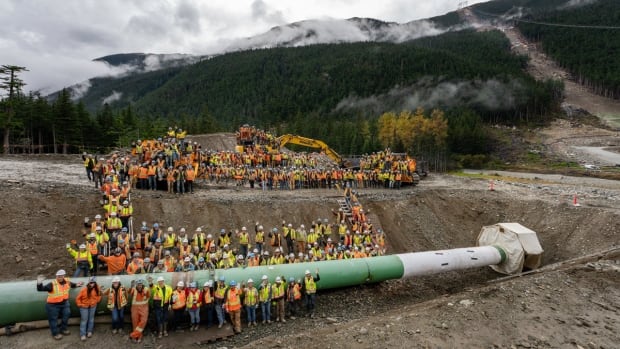A controversial pipeline meant to transport natural gas across northern British Columbia has passed a major milestone.
On Monday, TC Energy announced it has finished installing pipe on its Coastal GasLink pipeline project.
“That means that all 670 kilometres of pipe has been welded, coated, lowered into the trench, rigorously tested, and backfilled,” the company said in a release.
First planned more than a decade ago, the pipeline will carry natural gas from near Dawson Creek in the province’s northeast to a massive LNG Canada processing facility in Kitimat on the West Coast, where it is to be liquefied and shipped to Asia, opening up new markets for Canadian producers.
The final weld was completed Oct. 7 at the base of Cable Crane Hill near Kitimat, TC Energy said.
The company said mechanical completion of the pipeline, which involves final documentation, engineering analysis and testing, will be done before the end of the year.
Trials for pipeline opponents begin

Monday’s news came as the trials for several pipeline opponents, known as land defenders, got underway in Smithers, B.C.
While the pipeline has buy-in from several elected First Nations bands along its route, it has faced high-profile opposition from a group of hereditary chiefs who assert that Wet’suwet’en territory has never been ceded to the federal government and that pre-colonial governance structures are still responsible for the land.

In November 2021, 29 people were arrested over two days of police action in Wet’suwet’en territory as RCMP moved in on a resistance camp, known as Coyote camp, that had been occupying a key work site for Coastal GasLink, a number of whom are now facing charges of criminal contempt.
Two people pleaded guilty Monday to charges of criminal contempt for breaking a court order.
Human rights group Amnesty International is among those calling for the charges to be dropped, arguing the sovereignty of Wet’suwet’en leaders is being violated.
Multiple environmental violations
Opponents are drawing attention to the high number of environmental violations TC Energy has wracked up during construction of the pipeline.
In September 2023, the project was fined $346,0000 for erosion and sediment control issues and for providing false information in inspection records.
At the time, B.C.’s Environmental Assessment Office (EAO) said the fines were a reflection of “repeated non-compliance” with Coastal GasLink’s environmental responsibilities.
In total, the project has been issued more than 50 warnings since construction on the pipeline started in 2019, with inspection reports flagging “multiple infractions” — some of them repeat violations — on sensitive waterways, including the release of pollution into Fraser Lake, around 120 kilometres west of Prince George.
Major economic project
News of the pipeline’s pending completion was broadly hailed by the Canadian energy sector and industry watchers, who called it a significant step forward.
The Coastal GasLink pipeline is one of two major pipelines — the second being the Trans Mountain oil pipeline —expected to come online in the coming months. Both are viewed by Canada’s energy sector as potentially transformative, in terms of their ability to improve access to markets and to allow oil and gas companies to expand their production.
“First of all, just getting a pipeline to tidewater is huge,” said Heather Exner-Pirot, director of energy, natural resources and environment for the Macdonald-Laurier Institute.
“I think the last time we did this was the 1950s. So this (pipeline completion) is just stunning to think of in itself, for Canada.”
“But it also means we finally see some light at the end of the tunnel in terms of getting into the LNG [liquefied natural gas] game,” she added.
“We have just this incredible Montney reserve, this incredible reserve of natural gas, and now we can finally get some out to our own tidewater.”
As for opposition to the project, Exner-Pirot focused on the agreements TC Energy signed with 17 of 20 elected First Nations along the pipeline route.
Exner-Pirot said that kind of “groundbreaking” solution has essentially set the bar for Indigenous economic reconciliation in Canada when it comes to major resource project development going forward.
“Obviously the Wet’suwet’en blockades became what people know about Coastal GasLink,” she said.
“But for Coastal GasLink to offer an equity option before the pipeline was built was some very creative financial work to get Indigenous communities a piece of the action. There probably is no better example in Canada, from any sector, of how to involve Indigenous communities.”
LNG Canada export facility still under construction
The LNG Canada facility, which will be the first liquefied natural gas export facility in Canada, is still under construction.
But the company said in an update in July that the project is 85 per cent complete and is scheduled to begin exports by mid-decade.
LNG Canada, a more than $40-billion project, represents the single largest private investment in Canadian history.

Until it and Coastal GasLink come online, Canadian gas producers wishing to export LNG have no choice but to ship their natural gas from Western Canada all the way to LNG facilities on the U.S. Gulf Coast.
Goodman added that tapping into global LNG markets is critical for the future growth of the Canadian natural gas sector, which believes its product can be used as a cleaner-burning alternative to emissions-heavy coal in parts of Asia.
“This [Coastal GasLink] is critical from a natural gas production standpoint. Depending on how you’re looking at LNG growth, you could actually see a doubling of natural gas production [in Canada] in the coming years,” he said.


